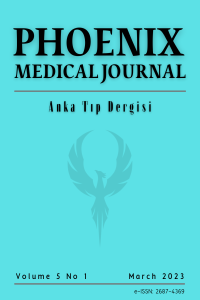Acil Servise Yılan Isırması Nedeniyle Başvuran Hastaların Demografik ve Klinik Özellikleri
Yılan ısırması, antivenom, acil.
Demographic and Clinical Characteristics of Patients Presenting to the Emergency Department with Snakebite
___
- 1. Kasturiratne A, Wickremasinghe AR, de Silva N. The global burden of snakebite: a literature analysis and modelling based on regional estimates of envenoming and deaths. PLoS Med. 2008;5:e218.
- 2. Gold Barry S, Dart Richard C, Barish Robert A. Bites of Venomous Snakes New England Journal of Medicine. 2002; 347(5):347.
- 3. Russell FE. When a snake strikes. Emerg Med. 1990;22(12):33–43.
- 4. Mackessy SP. Biochemistry and pharmacology of colubrid snake venoms.Journal of Toxicology-Toxin Reviews. 2002;21(1):43-83.
- 5. Baran İ, Başoğlu M. Türkiye Sürüngenleri, Kısım 2, Yılanlar Ege Üniversitesi. Basımevi, İzmir, 1998:9-25.
- 6. Gökel Y, Başlamışlı F, Koçak R. Çukurova yöresinden yılan ısırmaları. Çukurova Üniversitesi Tıp Fakültesi Dergisi. 1997;22:184-8.
- 7. Warrell DA. Treatment of snakebite in the Assia Passific: A personal view. In: Gopalaksishnakone P, Chou LM, eds. Snake of medical importance singapore venom ad. Toxin Research Group. National University of Singapore. 1990;641-70.
- 8. Jarwani B, Jadav P, Madaiya M. Demographic, epidemiologic and clinical profile of snake bite cases. J Emerg Trauma Shock. 2013;6(3):199-202.
- 9. Heiner JD, Bebarta VS, Varney SM, Bothwell JD, Cronin AJ. Clinical Effects and Antivenom Use for Snake Bite Victims Treated at Three US Hospitals in Afghanistan. Wilderness Environ Med. 2013 Jul 16. doi: 10.1016/j.wem.2013.05.001. [Epub ahead of print].
- 10. McKinney EP. Out of hospital and interhospital management of crotaline snakebite. Annals of Emerg Med. 2001;37(2):168-75.
- 11. Michael GC, Thacher TD, Shehu MI. The effect of pre-hospital care for venomous snake bite on outcome in Nigeria. Trans R Soc Trop Med Hyg. 2011;105(2):95-101.
- 12. Al-Durihim H, Al-Hussaini M, Bin Salih S, Hassan I, Harakati M, Al Hajjaj A. Snake bite envenomation: experience at King Abdulaziz Medical City East. Mediatr Health J. 2010;16(4):438-41.
- 13. Roberts JR, Otten EJ. Snakebites and other reptiles. In: Goldfrank LR, ed. Goldfrenk’ s Toxicolojic Emergencies. Stamford, CT: Appleton & Lange,1998:1603-23.
- 14. Tagwireyi DD, Ball D, Nhachi C. Routine prophylactic antibiotic use in the management of snakebite. BMC Clinical Pharmacology. 2001;1(4).
- 15. Clark R F, Selden BS, Furbee B. The incidence of wound infection following crotalid envenomation. J Emerg Med. 1993;11:583-6.
- 16. Scharman E J, Noffsinger D V. Copperhead Snakebites: Clinical severity of local effects. Annals of Emergency Medicine. 2001; 38(1): 55-61.
- 17. Açikalin A, Gökel Y. Serum IL-6, TNFα levels in snakebite cases occurring in Southern Turkey. Emerg Med J. 2011 Mar; 28(3): 208-11.
- 18. Juckett G, Hancox G J. Venomous snakebites in the United States: Management review and update. Am Fam Physician. 2002;65:1367-74.
- 19. Ibister GK, Brown SG, MacDonald E, White J, Currie BJ. Australian Snakebite Project Investigators. Current use of Australian snake antivenoms and frequency of immediate-type hypersensitivity reactions and anaphylaxis. Med J. 2008;188(8):473-6.
- Yayın Aralığı: Yılda 3 Sayı
- Başlangıç: 2019
- Yayıncı: İbrahim İKİZCELİ
Erkek Meme Kanseri İleri Değerlendirmesinde Meme MRG Kullanımı
rhDNAz (Dornase alfa) Nedir, COVID-19 Tedavisinde Yeri Var mıdır?
Korona Virus Enfekte Olguda Rastlantısal Akciğer Kitle Tanısı: Bir Olgu Sunumu
Türkan İKİZCELİ, Serhat ARAS, Rüştü TURKAY, Nurdan GOCGUN, Bahar ATASOY, Sevim ÖZDEMİR
Erişkin Karın Travma Hastalarının ve Karın İçi Solid Organ Yaralanmalarının Değerlendirilmesi
Rüptüre Akciğer Kist Hidatiği: Bir Olgu Sunumu
Eren USUL, Mehmet HOKE, Anıl GÖKÇE
Bir İntravenöz İntihar Olgusu: Sodyum Hipoklorit & Benzalkonyum Klorür
Serpil SOYUDOĞRU, Melike MERCAN BAŞPINAR, Okcan BASAT
Kadir DİBEK, Seda ÖZKAN, Sinan YILDIRIM, Selim GENÇ
Acil Servise Yılan Isırması Nedeniyle Başvuran Hastaların Demografik ve Klinik Özellikleri
Akkan AVCİ, Müge GÜLEN, Salim SATAR
Psoriasis Hastalarında C-Reaktif Protein Düzeyinin Hastalık Şiddeti ve Psoriatik Artrit İle İlişkisi
Şirin ÇELİK, Nahide ONSUN, Alkım ÇAKITER, Özlem KÜÇÜK, Aylin REZVANİ
